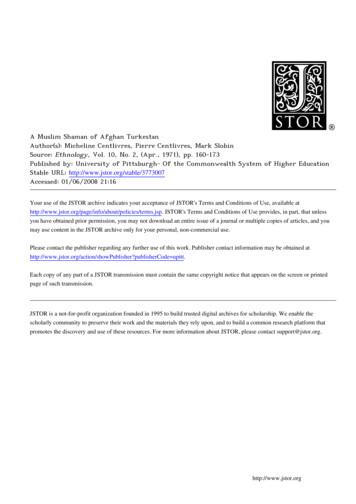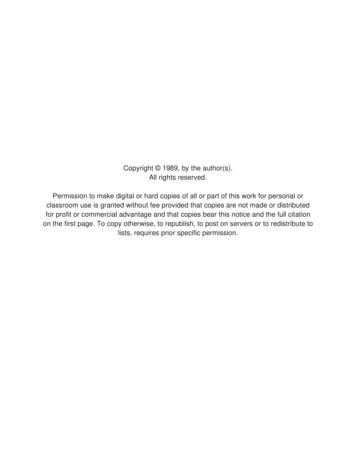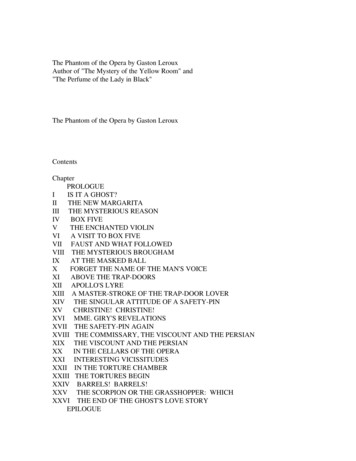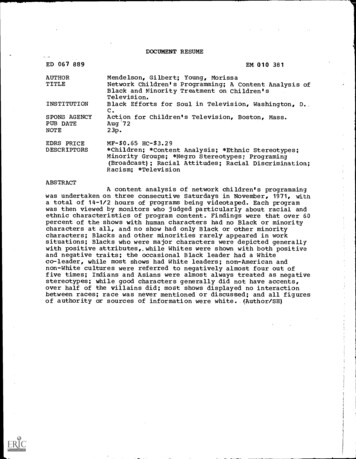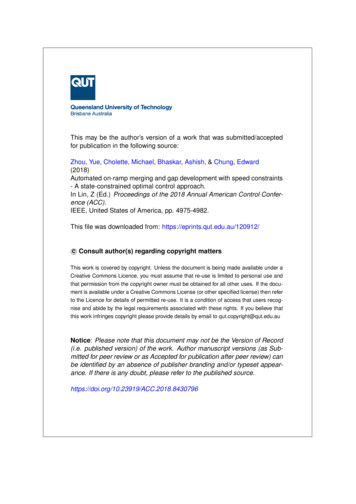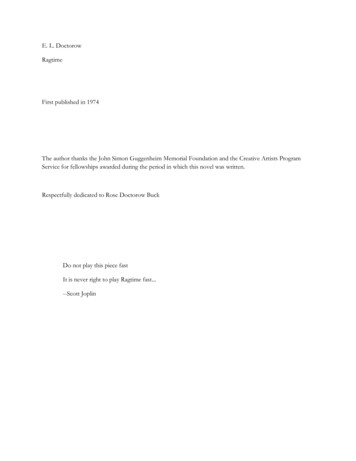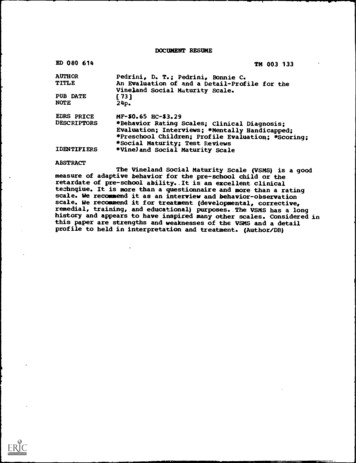
Transcription
Periodontal disease in a 15 year old Jack Russel bitch: A Case ReportAuthor: Dr. Lilyan Wanjiku Mathai, BVM (UON)J56/64630/2010Supervisor : Dr. J. D. Mande1
ABSTRACT:A 13 year old Jack Russell bitch was presented to the University of Nairobi Small Animal Clinicwith a history of halitosis and a persistent cough. Physical examination of the patient revealedpresence of dental plaque which had covered an extensive portion of the tooth crown in amajority of the teeth. Ascultaion of the lungs revealed harsh lung sounds audible in the apicallobes. Thoracic lateral and dorso-ventral views showed slight increased radioopacity of theapical lobes. Lateral and oblique views of the head showed increased radioopacity of the teethcrowns with no attachment loss at the gingiva. The dog was admitted for treatment of tracheabronchitis and dental tartar. Dental scaling was done under general anesthesia. Patient recoveredand was discharged 4 days later.INTRODUCTIONPeriodontal disease is described as a multifactorial infection that results from the interaction ofthe host defense mechanism with plaque microorganisms. Periodontal disease refers to a groupof inflammatory diseases caused by bacterial plaque in the periodontium. The disease can rangefrom early stage gingivitis to an advances periodontitis (Albuquerque et al, 2012). Factorsleading to progression of periodontal disease include; plaque, calculus, species, breed, genetics,home dental care, chewing behavior, saliva, local irritants, age and general health. The breed,increasing age and neutering are risk factors associated with periodontal disease. Periodontaldisease has a higher incidence in small breeds, with the Toy Poodle having the highest relativerisk of 3.8 and the Jack Russell having 1.8( Shearer P ).The primary cause is however dental2
plaque. Other factors which contribute to the accumulation of plaque include: feeding of softfoods, absence of oral hygiene, malocclusions of the teeth( especially in brachycephalic breeds),decreased resistance to infectious disease , nutritional disturbances, immunodeficiency andovercrowding of teeth (Albuquerque et a, 2012 ). Calculus is mineralized dental plaque thatadheres to the tooth surfaces and prosthetic dental materials. Accumulation of plaque is more onthe buccal surface of the maxillary teeth with the most severely affected being the carnasial teeth.Dental plaque affects periodontal disease by aiding in the bacterial adherence near the gingivalmargin.3
Fig 1. Lateral and oblique views of the head showing increased opacity of the teethstructures with no attachment loss of the periodontal membrane.4
CASE HISTORY AND MANAGEMENTA 10 kg 13 year old Jack Russell bitch (case no 36015) was presented to the University ofNairobi Small Animal Clinic with a history of halitosis and intermittent cough. Physicalexamination revealed that all vital parameters were within normal range. The de-worming andvaccination history were up to date. Examination of the buccal cavity revealed presence of dentalplaque which had covered an extensive portion of the carnasial and molar teeth crown. Themouth breath was fetid. Auscultation of the lungs revealed harsh lung sounds in the apical lobes.Palpation of the trachea found the cough to be inducible. Thoracic lateral and dorso-ventralviews showed slight increased radioopacity of the apical lobes lateral and oblique views the headshowed increased opacity of the teeth affected by callus deposition. Sedation was achieved by2% xylazine hydrochloride at a dose rate of 1mg per kilogram body weight and maintained withketamine at a dose rate of 2mg per kilogram body weight (lower dosage was used due to theadvanced age of the animal and compromised respiratory system). Scaling was done under lightsedation due to the compromised respiratory status and the age of the animal making it a pooranesthetic risk. The teeth were scaled using hand held scalers and the gross callus brocken downby use of extractors. The tooth area was cleaned with a 1:1 dilution of hydrogen peroxide whichacts as an oxidizing agent and bleaching agent for the teeth. In addition the hydrogen peroxideacts as a germicide to kill the bacteria adhering to tooth surface. Chlorhexidin antiseptic wasused to disinfect the wounded edges of the sub-gingival tissue.5
Post operative management involved antibiotics such as metronidazole (Flagyl 200mg)at adose rate of 25mg per kilogram body weight for 7 days (150mg bid, total dose of 2100mg peros). A pre-operative dose of amoxicillin trihydrate (Betamox ) 150mg and dexamothasone (Colvasone ) 2mg was administered intramuscularly to cater for the tracheobronchitis infection.The patient recovered and was discharged 6 days thereafter.DISCUSSIONThe salivary glycoprotein covering the teeth acts as the nidus for plaque formation as bacteriaadhere and become established in the pellicle. Plaque is an organic matrix of salivaryglycoproteins, oral bacteria and extracellular polysaccharides (bacterial by-products) thatattaches to the surface of the tooth. Polysaccharides and glycoproteins provide attachment for theplaque forming bacteria( Actinomyces sp., and streptococcus sp.) on the tooth surface. Inorganiccomponents of the supragingival plaque matrix are provided mainly by foodstuffs and saliva(Logan E. ). They include phosphorus and calcium with little amounts of magnesium, potassiumand sodium. The total inorganic content of early plaque is very low but it gradually increases asthe plaque is covered by calculus due to calcium deposition. Fluoride may also be incorporatedinto the plaque and is sourced from water, toothpaste, gels, food and other oral solutions. It mayact in determent of plaque bacterial metabolism, kill bacteria and aid in the mineralization ofenamel and dentin. Teeth act as a suitable surface to which bacteria can accumulate.Polysaccharides from bacterial by-products give plaque the characteristic ivory to yellowish tograyish appearance (Brook A.N). The proliferation of periodontopathogens leads toinflammation of the gingiva and may even cause irreversible damage to the gingiva. The6
multiplying pathogens release toxins and enzymes which cause degradation of the connectivetissue. This degradation may cause damage and lead to alveolar bone loss with subsequent toothloss or systemic disease once the vasoactive substances from the bacteria enter the circulatorysystem (Shearer P).Diagnosis of periodontal disease is made based on the presenting history, clinical signs exhibitedand oral examination. Radiographic evaluation of the teeth is used to determine the extent oftrauma and tooth pathology of structures beneath the gum. Dental radiography uses specialdental films and dental X-ray machines with a small aperture for teeth. Normal sized radiographmachines may also be used but oblique views are preferred due to the superimposition of teethonto each other ( Logan E).Common signs of periodontal disease include; gingivitis, plaque and calculus, purulent exudates,halitosis, ulcerations, loss of gingival stippling, gums that bleed easily when probed, loss of bonearound teeth, gum recession, tooth mobility, tooth migration, tooth loss, change of architecture ofgingival papillae, tooth extrusion and pocket formation around teeth (Shearer 2006).The severity of the signs exhibited leads to the classification of periodontal disease into severalcategories (Albuquerque et al, 2012).Stage 1 periodontal disease (gingivitis) this is characterized by gingivitis with significantcalculus deposits and minimal gingival inflammation. Some cases may have profuseinflammation with little plaque and calculus present.Stage 2 periodontal disease (early); there are initial signs of destructive periodontitis. Probingand radiographic examination may show signs of attachment loss.7
Stage 3 periodontal disease (moderate); there is attachment loss of 25-50% of the root length.Probing and radiographic signs are more pronounced.Stage 4 periodontal disease (severe); attachment loss is more than 50% with infra-bony pocketslocalized to single areas as deep palatal pockets in the maxillary teeth. Bone destruction due toplaque metabolites averages 1.5-2.5mm.Other types of classification include pathobiological classification which categorizes peiodontitisinto Adult (AP), Rapidly progressive (RPP), localized juvenile (RJP), prepubertal (PP) andrefractory rapidly progressive (RRPP) (Albuquerque et al, 2012) .Treatment of periodontitis is aimed at removal of plaque and calculus and subsequent preventionof recurrence. It can be divided into professional prophylaxis, antimicrobial therapies,periodontal surgeries, dental surgeries and home prophylaxis. The extent of treatment varies withthe extent of periodontitis.CONCLUSIONThe occurrence of dental calculus in the small breed such as the Jack Russell as in the case reportwas due to several predisposing factors: breed, age and poor dietary supplementation. Whereasdental scaling offers a temporary relief of the periodontal disease, regular home care cleaningand change in the feeding types will be required for the long term management of the disease dueto the predisposing factors encountered. The use of special formulated diets and chews anddental treats will prevent the accumulation of plaque of the tooth surface.8
REFERENCESAlbuquerque C., Morinha F., Requicha J., Martins T., Dias T., Quedes-pinto H., Bastos E.and Viegus C. (2012). Canine periodontitis: the dog as an important model for peiodontalstudies. Veterinary journal 191:299-305 www.2ndchance.info/bones-Albuquerque2012.pdf Assessedon April 2013Brook A.N. Periodontal disease. www.dogbeachdentistry.com tal-Disease.pdf Assessed on April 2013Logan I. E. periodontal Disease In “Small Animal clinical nutrition”. Chapter 47: pgs eriodontal%20Disease. Assessed on April 2013Patrick Shearer (2006). Periodontal literature 3e8fac47de3a.p. Assessed on April 2013Reiter A. M. and Harvey C. E., periodontal and ab/chap22/chapter.asp?LA 1 Assessed on April 2013Wiggs R.B and Lobprise H.B. Periodontology In “Veterinary Dentistry- Principles andPractice” Lippincott-Raven, Philadelphia New York pg 186-231.9
overcrowding of teeth (Albuquerque et a, 2012 ). Calculus is mineralized dental plaque that adheres to the tooth surfaces and prosthetic dental materials. Accumulation of plaque is more on the buccal surface of the maxillary teeth with the most severely affected being the carnasial teeth.
